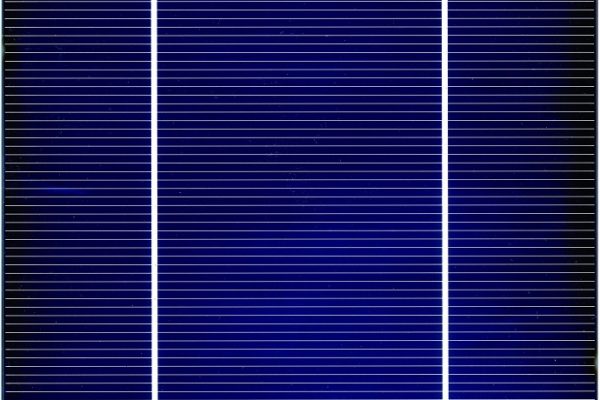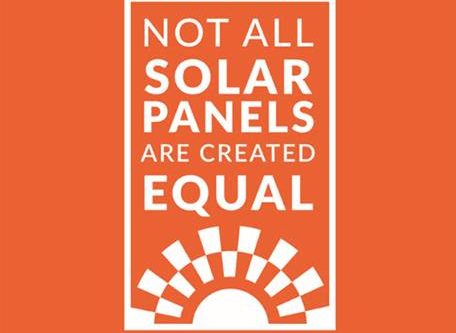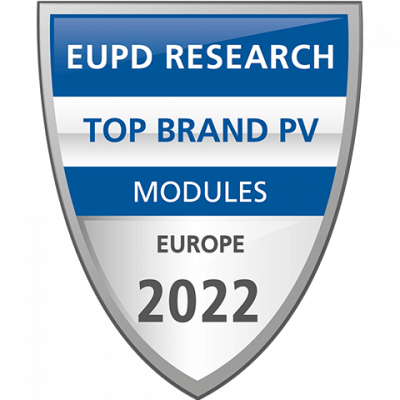Converting sunshine to electricity
In just 1 hour, the earth gets more energy from the sun than our society consumes in a year. Make the sun your new energy supplier. The photovoltaic effect makes it possible to generate electricity from sunlight. Each photovoltaic solar panel consists of many cells, these cells are made of silicon, a semi-conducting material. These silicon cells absorb sunlight and electrons are set in motion creating an electric current.
Fill out the application

How do solar panels work?
Photovoltaic panels are made of 8 major components:
1. Aluminium frame
2. Tempered cover glass
3. Encapsulation foil 1
4. Solar cells
5. Encapsulation foil 2
6. Back sheet
7. Junction box(es)
Solar photovoltaic cells convert sunlight into electrical energy. The solar energy is conducted via small metal strips (fingers) on the solar cells to wider metal strips (bus bars), which collect the energy and transport it to the junction box(es) on the back of the module. Via the junction box the solar panel is connected to other PV modules to form a string. A solar installation then usually consists of several strings.
What to consider when choosing solar panels?
Before deciding on PV panels, you should check these criteria:
✓ Trustworthiness of the brand
For a safe investment, you should choose a well-known and bankable (Tier 1) solar brand with a successful track record for many years.
✓ PV panel output and efficiency
The performance of a solar panel is stated in WP (watt peak, also referred to as wattage) and the efficiency in %. The higher the values, the better, but you should also consider the costs per Wp.
✓ Product guarantee
The product warranty is a guarantee on product material and workmanship, and covers your solar panels should you find issues caused by a manufacturing defect.
✓ Power output guarantee (degradation)
The solar panel performance warranty provides a guarantee that your solar panels will perform at a certain level of efficiency after a specific number of years (e.g. during 25 years).
✓ Solar panel certificates/test
Solar modules are usually tested under extreme conditions (e.g. ammonia, salt mist, sand and PID resistance) and have the corresponding certificates.

What is a Tier 1 solar panel?
Term “Tier 1” gets used quite liberally and frequently by many solar sales companies who use it to describe their solar panels as being of a high quality. The Tier 1 ranking scale is orchestrated by Bloomberg New Energy Finance Corporation and is used to rank solar panel manufacturers in terms of their bank-ability or financial stability.
Bank would not fund a large-scale project worth say 100 million Euro if the product used was likely to fail in the short-term thus, inadvertently, a Tier 1 solar panel is a high quality panel or should we say a solar panel that is designed to produce power for as long as the expected lifespan which is around 25 years. The other reason why one can make the assumption that a Tier 1 solar panel is a quality panel is based on the criteria set by Bloomberg in that only solar panel manufacturers that own their own manufacturing facility can be included for review. If a solar company outsources the manufacturing of its panels then it will not be included on the Tier 1 list. If a company owns its own manufacturing facility then you know that there will be strict quality control guidelines in place which ultimately will result in better and more reliable product! Companies having invested in their own manufacturing are also investing into research and development of their product.
It is important to note that only a very small percentage of the world’s solar panel manufacturers achieve Tier 1 ranking so be very wary if a solar sales representative makes a claim that their solar panel is a tier 1 panel.

The 2022 Tier 1 Solar Panel List is now available. See what solar module manufacturing companies made the list below. Please note that it is updated every quarter.
| Manufacturers | Q1 | Q2 | Q3 | Q4 |
| Adani / Mundra | ✓ | ✓ | ||
| AE Solar | ✓ | ✓ | ||
| AKCOME |
| ✓ | ||
| AU Optronics | ✓ | ✓ | ||
| Beyond Sun | ✓ | ✓ | ||
| Boviet | ✓ | ✓ | ||
| BYD | ✓ | ✓ | ||
| Canadian Solar | ✓ | ✓ | ||
| CECEP | ✓ | ✓ | ||
| CGS |
| ✓ | ||
| Chint / Astronergy | ✓ | ✓ | ||
| Dehui | ✓ | ✓ | ||
| DMEGC | ✓ | ✓ | ||
| Dongfang | ✓ | |||
| Eging | ✓ | ✓ | ||
| ET Solar Inc | ✓ | ✓ | ||
| Exiom Group | ✓ | ✓ | ||
| First Solar | ✓ | ✓ | ||
| GCL System | ✓ | ✓ | ||
| Goldi Solar |
| ✓ | ||
| Green Wing |
| ✓ | ||
| Haitai | ✓ | ✓ | ||
| Hansol Technics | ✓ | ✓ | ||
| Hanwha Q Cells | ✓ | ✓ | ||
| Heliene |
| ✓ | ||
| Hevel | ✓ | ✓ | ||
| HT-SAAE | ✓ | ✓ | ||
| HuaSun Energy |
| ✓ | ||
| Hyundai | ✓ | ✓ | ||
| JA Solar | ✓ | ✓ | ||
| Jetion | ✓ | ✓ | ||
| Jinneng / Jinergy | ✓ | ✓ | ||
| Jinko | ✓ | ✓ | ||
| Jolywood | ✓ | ✓ | ||
| Leapton Energy | ✓ | ✓ | ||
| LG Solar | ✓ | ✓ | ||
| LONGi Solar | ✓ | ✓ | ||
| Meyer Burger |
| ✓ | ||
| Motech | ✓ | ✓ | ||
| Neo Solar Power (NSP) / URE | ✓ | ✓ | ||
| New East Solar Energy |
| ✓ | ||
| Philadelphia Solar |
| ✓ | ||
| REC Group | ✓ | ✓ | ||
| Recom | ✓ | ✓ | ||
| Renesola Yixing | ✓ | ✓ | ||
| Renewsys | ✓ | ✓ | ||
| Risen Energy | ✓ | ✓ | ||
| S-Energy | ✓ | ✓ | ||
| Seraphim / SEG | ✓ | ✓ | ||
| Sharp | ✓ | ✓ | ||
| Shinsung | ✓ | ✓ | ||
| Solargiga | ✓ | ✓ | ||
| Sumec / Phono Solar | ✓ | ✓ | ||
| Sunport | ✓ | ✓ | ||
| SunPower / Maxeon | ✓ | ✓ | ||
| Suntech | ✓ | ✓ | ||
| Swelect | ✓ | ✓ | ||
| Talesun | ✓ | ✓ | ||
| Tongwei | ✓ | ✓ | ||
| Trina Solar | ✓ | ✓ | ||
| TSEC | ✓ | ✓ | ||
| Ulica Solar | ✓ | ✓ | ||
| UREC | ✓ | ✓ | ||
| Vikram | ✓ | ✓ | ||
| VSUN Solar | ✓ | ✓ | ||
| Waaree | ✓ | ✓ | ||
| Yingli Silfab | ✓ | ✓ | ||
| ZNShine | ✓ | ✓ |
Solar Panel Efficiency
Solar panel efficiency is measured under standard test conditions (STC), based on a cell temperature of 25°C, solar irradiance of 1000W/m2 and Air Mass of 1.5. The efficiency (%) of a panel is effectively calculated by dividing the maximum power rating or Pmax (W) at STC, by the total panel area measured in meters squared.


Solar panel efficiency is a measure of the amount of sunlight (irradiation) that falls on the surface of a solar panel and is converted into electricity. Due to the many advances in photovoltaic technology over recent years, the average panel conversion efficiency has increased from 15% to well over 20%. This large jump in efficiency resulted in the power rating of a standard size panel to increase from 250W up to 400W and more.
Solar panel efficiency is determined by two main factors; the photovoltaic (PV) cell efficiency, based on the cell design and silicon type, and the total panel efficiency, based on the cell layout, configuration and panel size.
Saules paneļa efektivitāti nosaka divi galvenie faktori; fotoelementu (PV) elementu efektivitāte, pamatojoties uz elementu konstrukciju, silīcija tipu un kopējo paneļa efektivitāti pamatojoties uz šūnas izkārtojumu, konfigurāciju un paneļa izmēru.
Cell Efficiency
Cell efficiency is determined by the cell structure and type of substrate used, which is generally either P-type or N-type silicon. Cell efficiency is calculated by what is known as the fill factor (FF), which is the maximum conversion efficiency of a PV cell at the optimum operating voltage and current.
The cell design plays a significant role in panel efficiency. Key features include the silicon type, busbar configuration, and passivation type (PERC). Panels built using high-cost IBC cells are currently the most efficient (20-22%) due to the high purity N-type silicon substrate and no losses from busbar shading. However, panels developed using the latest monocrystalline PERC cells and more advanced heterojunction (HJT) cells have achieved efficiency levels well above 20%.

Certificates/tests/appreciations/awards

The ``Ultra Low-Carbon Solar Alliance``
Is particularly focused on ``Embodied carbon``. Embodied carbon includes greenhouse gas emissions related to PV materials, product production and transportation. As investment in solar power is known as the solution to curbing greenhouse gases, the ``Ultra Low-Carbon Solar Alliance`` takes decarbonization to a new level and explores ways to reduce environmental impact.
PVEL Top Performers Scorecard.
DNV GL is a global leader in independent consulting, analysis, technology, inspection, certification, monitoring, control and asset management services in a variety of industries including renewable energy. An appraisal agency that works with investors, project developers, system owners, power suppliers and equipment manufacturers to manage the overall project risk and system performance and safety, from home PV systems to large-scale power plants.


QUALITY CONTROLLED PV TÜV - seal for the most reliable
The new “Quality Controlled PV” of the independent certification institute TÜV Rheinland. institute continuously test solar modules in mass production far beyond the usual approval certification in accordance with the future IEC TS 63209 – the “Extended Stress Test for PV Modules” – and also monitor materials and component suppliers
N-TV GERMANY,S MOST POPULAR PROVIDER LIFE & LIVING AWARD 2022
The N-TV German award is given to companies for the reputation of excellence and high-quality products in the home consumer market, 11 brands are evaluated (in the PV sector) in the survey. Also, the award is given in a category by asking consumers whether they would use the brand again. N-TV
and the German Service Quality Institute collaborate each year to award these awards, which are based on ratings from more than 40,000 customer reviews. In total, more than 600 companies in various industries are evaluated.


RED DOT AWARD
The Red Dot Design Award is an international design award given by Red Dot GmbH & Co
The competition is organized annually to review and recognize the best products of the year worldwide.
``TIER 1`` HIGH QUALITY PRODUCTS
The Tier 1 rating scale is organized by Bloomberg New Energy Finance Corporation and is used to rank solar panel manufacturers based on their bankability or financial stability.


Approved seal of the EuPD Research Institute.
“TOP BRAND PV Europe 2022” is top module manufacturer in a satisfaction survey targeting solar power installation companies conducted annually by EuPD Research, a global third-party organization for solar power generation.
WINNER IN PRODUCT INNOVATION
Intersolar Award Jury, Solar Power Portal Award Jury and PV Magazine Jury Award for Best Innovation


SOLAR + POWER AWARD FOR EXCELLENCE - INNOVATION
The Solar + Power Award was created in 2011, to recognise the whole value chain and those people, products and services that develop innovative manufacturing and product approaches. The Solar + Power Award categories consider the whole value chain from materials to end product, from process to individual.
PV Magazine Top Innovation Award
The PV magazine award is given to battery energy storage systems (BESS), balance of systems (BOS), solar inverters, manufacturers and PV modules.


INTERSOLAR AWARD - WINNER
Intersolar - The World's Leading Exhibition organizers for the Solar Industry honors pioneers and innovators in the energy sector for the invaluable contribution they make to the industry and society as a whole. The best will receive Intersolar AWARD.
FORBES home
Top 5 Best Solar Panels For Homes 2023
With the expanding market comes an ever-increasing number of companies vying for your business. The competition is heating up, and that’s good news for consumers. Competition drives innovation while keeping prices in check. However, the increasing number of solar panel manufacturers and the long lists of available options can confuse those trying to determine the best energy solution for their homes.
To help, we’ve taken a hard look at the top solar panel makers and their product lineups to compile our list of the top five in the business. We’ve listed them here, along with crucial information to consider when deciding which provider has the best solar panels for your home.


